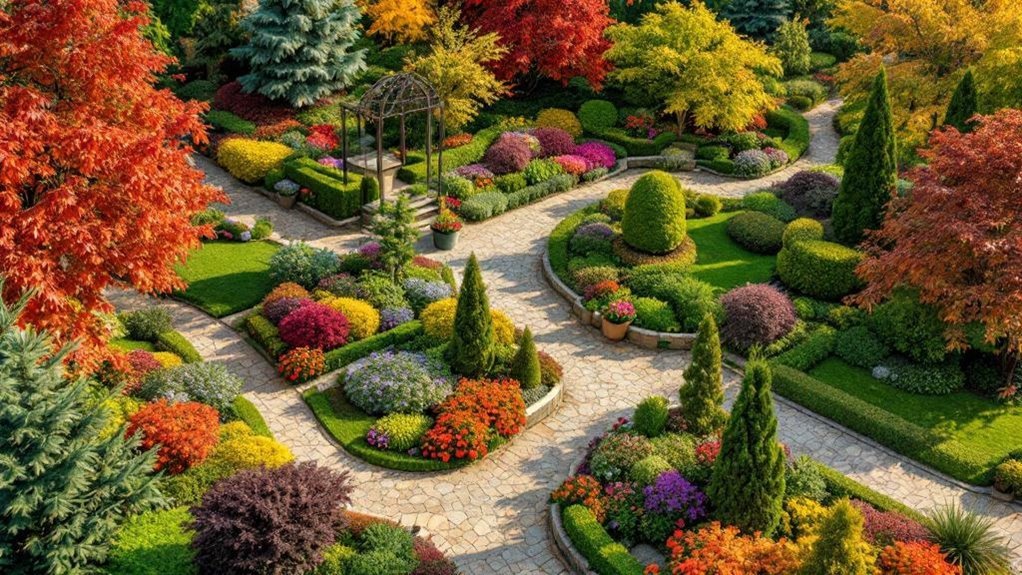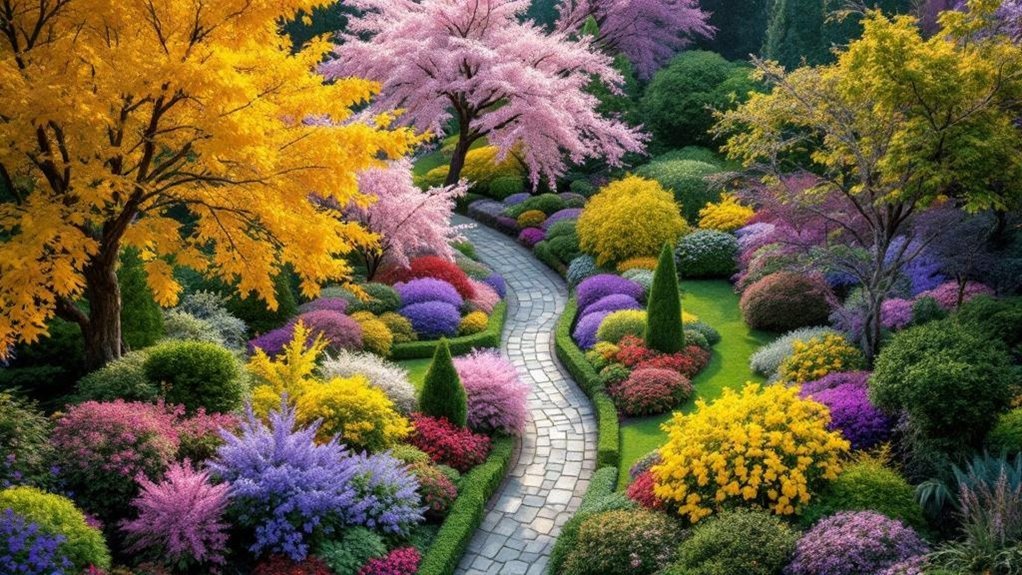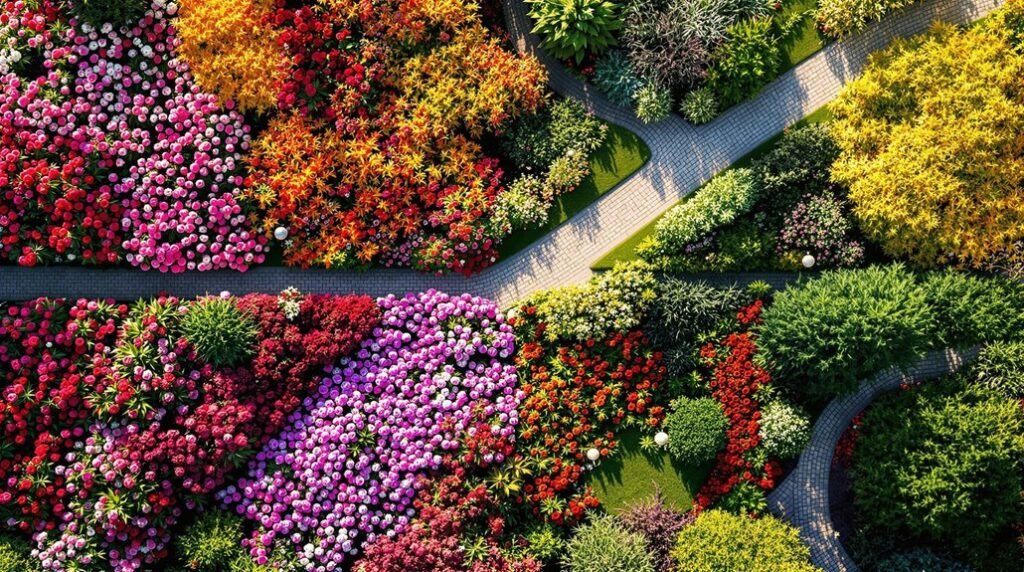When you decide to create a four-season garden, you’re setting out to enjoy beauty no matter the month. It’s about more than just picking pretty flowers—it requires understanding your site’s unique conditions and planning for interest throughout the year. By layering plants and incorporating structure thoughtfully, you can craft a space that shifts gracefully with the seasons. But where do you start to guarantee your garden thrives all year long?
Understanding the Concept of a Four-Season Garden
A four-season garden blends native plants, perennials, annuals, flowering shrubs, and ornamental trees to keep your outdoor space vibrant year-round.
To achieve year-round beauty, you’ll need thoughtful planning and careful plant selection, focusing on a diverse mix that offers continuous seasonal interest. Don’t just think about spring and summer blooms; include species that provide winter interest, like evergreens or plants with attractive bark and berries.
This approach guarantees your garden delivers sensory delight through changing textures, colors, and scents in every season. By designing with all four seasons in mind, you create a dynamic outdoor environment that’s not only visually appealing but also supports local wildlife.
Embracing a four-season garden transforms your space into a lively, evolving sanctuary throughout the entire year.
Assessing Your Site Conditions and Climate
To create a thriving four-season garden, you’ll first need to evaluate the specific conditions of your site and climate.
Start by identifying your USDA zone, which guides plant selection suited to your temperature range. Next, observe sunlight availability throughout the day to place plants where they’ll flourish.
Identify your USDA zone and track sunlight to select the best spots for thriving plants.
Test your soil type for pH and nutrients to guarantee healthy growth. Don’t overlook microclimates—sheltered spots near structural elements like walls or fences can support diverse plants.
Also, assess water availability and drainage to prevent root problems and inform irrigation needs. Understanding these factors helps you choose plants that thrive year-round, making your garden both resilient and beautiful in every season.
Designing Garden Structure for Year-Round Interest

While deciduous plants lose their leaves in winter, you can keep your garden visually engaging year-round by designing a strong structure. A well-planned garden structure reveals your landscape design’s framework, especially in the winter landscape when blooms disappear.
To create structure and maintain year-round interest, focus on these design ideas:
- Incorporate evergreen shrubs and borders to provide color and shape during dormant seasons.
- Use layering in garden beds—place taller plants at the back and shorter ones in front—to add depth and visual appeal.
- Add hardscaping elements like patios, pathways, or arbors as focal points that enhance the garden’s form throughout the year. Additionally, consider galvanized steel raised beds for durability and an attractive aesthetic that complements your garden design.
Building a Framework With Evergreens
Incorporating evergreens like conifers and holly gives your garden a solid framework that stays vibrant through every season.
When designing a garden, using evergreen trees and shrubs guarantees year-round visual appeal, especially providing winter structure and interest when other plants lie dormant. You can create a landscape with distinctive forms—such as the vertical ‘Sky Pencil’ holly—that serve as striking focal points.
Tall evergreens offer privacy and define spaces, while low-growing varieties establish order along borders. Their varied textures add depth and diversity, keeping your garden engaging throughout the year.
Selecting Trees, Shrubs, and Perennials for Continuous Bloom

Although planning a four-season garden can seem challenging, selecting the right mix of trees, shrubs, and perennials guarantees continuous blooms from spring through winter.
To enhance your garden design with year-round visual appeal, focus on these key plants:
- Choose trees like redbuds and dogwoods for early spring blooming, attracting pollinators and adding vibrant color.
- Incorporate summer-blooming shrubs such as hydrangeas and butterfly bushes, which thrive on new growth and create lush displays.
- Select perennials like coneflowers and daylilies that offer long-lasting summer blooms and attractive seed heads for winter interest.
Don’t forget fall foliage from shrubs like ninebark and winter visual appeal from evergreens and berry-producing shrubs to keep your garden lively throughout all seasons.
Incorporating Hardscaping and Garden Features
When you add hardscaping elements like patios, walkways, and arbors, you create a strong structure that supports your garden’s beauty throughout the year.
Incorporating hardscaping into your outdoor space adds non-living features that enhance visual interest and provide contrasting textures alongside plants. Materials like stone, wood, and brick enrich your landscape plan, making it more visually appealing in every season.
Use focal points such as fountains, birdbaths, or kinetic sculptures to maintain engagement, especially during dormant periods. Thoughtfully placing these features helps define garden areas and guides seasonal changes, ensuring a cohesive design that flows naturally.
Planning Color and Texture for Every Season
To keep your garden vibrant all year, you’ll want to choose plants that offer color and texture through every season.
Focus on combining evergreen plants for winter structure, flowering shrubs for seasonal blooms, and plants with interesting seed heads to add year-long visual interest.
Here’s how to plan:
- Use evergreens like boxwoods to maintain color contrasts during dormant months and support plants for winter.
- Incorporate flowering shrubs that bloom in different seasons to guarantee continuous color and texture.
- Add plants with unique seed heads or bark, such as Paper Birch, to provide intriguing textures and interest when flowers fade.
Choosing Plants for Spring and Summer Appeal
Since spring and summer bring the most vibrant growth and color, you’ll want to select plants that thrive in these seasons and keep your garden lively.
Start with early-blooming bulbs like daffodils, tulips, and crocuses to add fresh color as winter fades. Incorporate flowering shrubs such as forsythia and lilacs to boost visual interest and attract pollinators.
For summer, choose long-blooming perennials like coneflowers, black-eyed Susans, and daylilies that flourish in full sun and sustain color throughout the seasons. Fill any gaps with annuals like zinnias and petunias, which offer bright bursts of color and are easy to replace yearly.
Finally, mix in structural plants, including ornamental grasses and flowering shrubs, to create depth and maintain your garden’s dynamic appearance during spring and summer.
Enhancing Fall and Winter Garden Aesthetics
Although vibrant blooms fade in fall, you can still keep your garden visually striking by incorporating colorful stems and berries from plants like winterberry holly and red twig dogwood.
To enhance your winter garden’s visual interest, try these tips:
Enhance your winter garden’s charm with vibrant plants, textured bark, and dynamic evergreens for year-round beauty.
- Add fall-blooming plants such as asters and goldenrod to extend seasonal interest into colder months.
- Use ornamental grasses like switchgrass and fountain grass to introduce movement and texture during winter winds.
- Select trees and shrubs with unique bark textures—paper birch and coral bark maple add sculptural beauty.
Don’t forget to include evergreen shrubs for year-round structure and color.
Grouping plants of varying heights, from tall evergreens to ground cover like hellebores, creates depth and keeps your fall and winter garden enthralling.
Frequently Asked Questions
What Is the 70/30 Rule in Gardening?
The 70/30 rule means you plant 70% perennials and shrubs for lasting structure, and 30% annuals for vibrant seasonal color. You’ll get a balanced, low-maintenance garden that looks great all year long.
How to Plan a Four Season Garden?
Imagine vibrant blooms, lush greenery, and snowy silhouettes. You’ll mix evergreens, flowering plants, and textured shrubs, layering heights and colors. Track bloom times and add hardscaping to craft a garden that shines through every season’s mood.
What Is the Gardening 3 Year Rule?
The Gardening 3 Year Rule means you’ll see minimal growth the first year as roots develop. By year two, plants grow more vigorously, and by year three, they reach full size and bloom, showing their true potential.
How to Have a Garden That Blooms All Year Round?
Imagine vibrant petals unfolding beneath winter’s frost. You’ll choose bulbs, perennials, and evergreens blooming sequentially, layer plants by height, and adjust your layout regularly to keep your garden colorful and lively through every season.
Final Thoughts
By evaluating your site, choosing diverse plants, and layering textures, you create a garden that blooms in spring, thrives in summer, glows in fall, and endures through winter. You’ll build structure with evergreens, add bursts of color with seasonal blooms, and enhance interest with thoughtful hardscaping. Embrace the changing seasons, plan with purpose, and watch your garden transform into a vibrant, year-round sanctuary you’ll love to enjoy every day.
